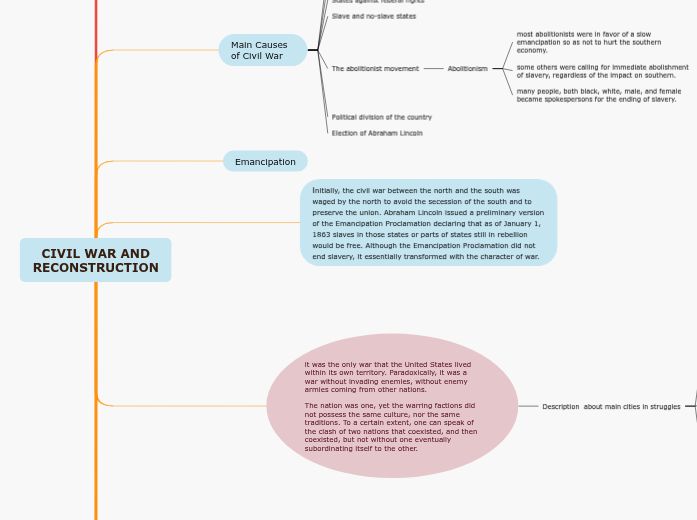CIVIL WAR AND RECONSTRUCTION
Important Characters
Abraham Lincoln 1809-1865
He became the sixteenth president of the United States of America. He held the presidency from march 1861- april 1865.
main achievements
abolition of slavery
strengthening of the federal state
modernization of the economy
Ulysses S. Grant 1822-1885
General command of the army of the United States during the last part if the Civil War, between 1864-1865. He then became the 18th president of the United States, from 1869-1877.
He was the main executor of the national reconstruction plans after the war ended.
Jefferson 1808-1889
American military and statesman, he served as President of the Confederacy during the Civil War from 1861-1865. He was organizer of the Confederate Army.
Robert Edward Lee 1807-1870
He was the General Commander of the Confederate Army of Northern Virginia in the American Civil War between 1862-1865. He fought during the Mexico-United States and was superintendent at West Point.
Main Causes of Civil War
Slavery
Difference between north and south
States against federal rights
Slave and no-slave states
The abolitionist movement
Abolitionism
most abolitionists were in favor of a slow emancipation so as not to hurt the southern economy.
some others were calling for immediate abolishment of slavery, regardless of the impact on southern.
many people, both black, white, male, and female became spokespersons for the ending of slavery.
Political division of the country
Election of Abraham Lincoln
Emancipation
initially, the civil war between the north and the south was waged by the north to avoid the secession of the south and to preserve the union. Abraham Lincoln issued a preliminary version of the Emancipation Proclamation declaring that as of January 1, 1863 slaves in those states or parts of states still in rebellion would be free. Although the Emancipation Proclamation did not end slavery, it essentially transformed with the character of war.
it was the only war that the United States lived within its own territory. Paradoxically, it was a war without invading enemies, without enemy armies coming from other nations.
The nation was one, yet the warring factions did not possess the same culture, nor the same traditions. To a certain extent, one can speak of the clash of two nations that coexisted, and then coexisted, but not without one eventually subordinating itself to the other.
Description about main cities in struggles
North
Emerged with a strong and growing industrial economy.
Foundation fo the industrial Revolution.
The united States becomes a global economic power.
South
Farms, railroads, and factories destroyed.
Cities in ruins.
Labor shortage, no more slavery.
Confederate and worthless.
Remained an agricultural economy and poorest section.
West
Huge economic boom.
Economy based on agriculture, mining and railroads.
Transcontinental Railroad is completed (1869), increasing movement west.
Civil War Amendments
13th Amendment (1865)
bans slavery in the United States
14th Amendment (1868)
grants citizenship to all persons born or naturalized in US. Also, government cannot deny anyone equal protection of the law.
15th Amendment (1870)
the right to vote shall not be denied based on rae.
Effects and consequences of the war
Emancipation
on January 1st, 1863, president Lincoln declare all slaves liberated and free.
Deaths
The Civil War by far the deadliest war in American history. Well, over 600,00 people died.
Reconstruction
The period of time after the Civil War is known as Reconstruction during this difficult era, the Southern states were gradually admitted back into the Union and areas destroyed during the war were rebuilt.
Lincoln´s Death
Five days after he won the war murdered in a theatre with a shot on his head by John Wilkes Booth.
